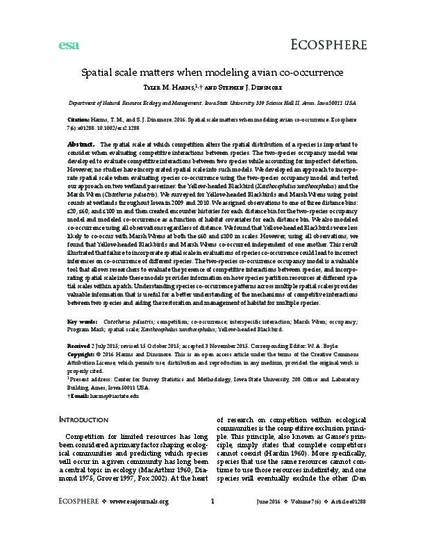
The spatial scale at which competition alters the spatial distribution of a species is important to consider when evaluating competitive interactions between species. The two-species occupancy model was developed to evaluate competitive interactions between two species while accounting for imperfect detection. However, no studies have incorporated spatial scale into such models. We developed an approach to incorporate spatial scale when evaluating species co-occurrence using the two-species occupancy model and tested our approach on two wetland passerines: the Yellow-headed Blackbird (Xanthocephalus xanthocephalus) and the Marsh Wren (Cistothorus palustris). We surveyed for Yellow-headed Blackbirds and Marsh Wrens using point counts at wetlands throughout Iowa in 2009 and 2010. We assigned observations to one of three distance bins: ≤20, ≤60, and ≤100 m and then created encounter histories for each distance bin for the two-species occupancy model and modeled co-occurrence as a function of habitat covariates for each distance bin. We also modeled co-occurrence using all observations regardless of distance. We found that Yellow-headed Blackbirds were less likely to co-occur with Marsh Wrens at both the ≤60 and ≤100 m scales. However, using all observations, we found that Yellow-headed Blackbirds and Marsh Wrens co-occurred independent of one another. This result illustrated that failure to incorporate spatial scale in evaluations of species co-occurrence could lead to incorrect inferences on co-occurrence of different species. The two-species co-occurrence occupancy model is a valuable tool that allows researchers to evaluate the presence of competitive interactions between species, and incorporating spatial scale into these models provides information on how species partition resources at different spatial scales within a patch. Understanding species co-occurrence patterns across multiple spatial scales provides valuable information that is useful for a better understanding of the mechanisms of competitive interactions between two species and aiding the restoration and management of habitat for multiple species.
Available at: http://works.bepress.com/stephen_dinsmore/101/

This article is published as Harms, Tyler M., and Stephen J. Dinsmore. "Spatial scale matters when modeling avian co‐occurrence." Ecosphere 7, no. 6 (2016). Doi: 10.1002/ecs2.1288.